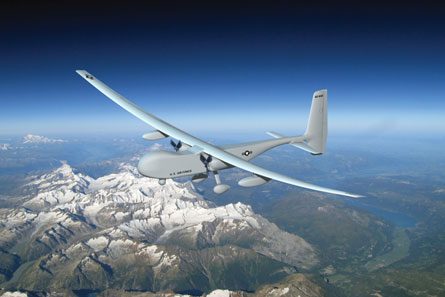A new kind of aircraft is poised to enter a crowded market for medium-altitude, fixed-wing surveillance aircraft, offering “extreme persistence” as its competitive trump card.
Virginia-based Aurora Flight Sciences plans to launch flight tests for the Orion unmanned aircraft system by the end of the year and demonstrate 120h, or five-day, endurance before October.
The Orion marks yet another expression of the Department of Defense’s desire to flood the skies over Afghanistan with never-ending surveillance coverage of virtually the entire country.
 |
|---|
© AuroraOrions could provide never-ending surveillance over Afghanistan |
In tackling the challenge of extreme persistence at medium altitude, Aurora has chosen a technology strategy that balances the risks posed by long-endurance flight with a conventional airframe and propulsion system.
The Orion does not seek to introduce extreme persistence at the cost of requiring liquid hydrogen, which as a fuel source has proved popular in high-altitude experiments, but is difficult to store and can be dangerous to handle.
Rather, Aurora’s medium-altitude alternative to a host of both manned and unmanned surveillance already clogging the market space relies on standard military aviation fuels to create energy.
Aurora’s choice of an engine also shows the programme’s conventional approach. The Orion will be powered by two Austro engines, which were certificated for flight only a year ago. But the Austro engines follow a proven path, succeeding the Thielert engine family as the future powerplant for Diamond Aircraft. Both of the Orion’s Austro AE300 will produce 168hp (123kW) of power, driving two three-bladed propellers.
Aurora has designed the Orion to cruise at 15,000ft (4,580m) with a 455kg (1,000lb) payload for five days, according to programme documents.
In a 2009 briefing by the Department of Defense officials, the Orion’s loitering ability was described in specific detail. Based at Anderson AFB, Guam, the Orion is able to commute 1,740nm (3,220km) to and from airspace near North Korea, and loiter on station for 70h.
The Orion’s nearest competitor – the General Atomics MQ-1B Predator – carries about half the payload weight and would have to be based in South Korea to provide even half the loitering capability during a single sortie.
With such a platform, Aurora is seeking to revolutionise the market’s definition of adequate loiter time. Only 10 years ago, the 30h-sortie capability of the Predator was described as transformational. If Aurora’s design is successful, such presence may soon seem outdated.
It is not clear, however, that the USAF wishes to sacrifice the billions of dollars already spent on establishing the Predator and its larger and more capable sister aircraft – the MQ-9 Reaper.
The Orion’s supporters have built the business case for Orion by bypassing the question of whether the Aurora design should replace the Predator/Reaper fleet.
Instead, the same briefing document, which was presented to US Africa Command in Stuttgart, Germany, proposes an alternative route into the USAF inventory.
In the past two years, an insatiable demand for aerial imagery and intelligence data drove the USAF to acquire a new manned aircraft – the L-3 Communications/Beechcraft MC-12 Liberty. L-3 is scheduled to deliver the last of the 37 converted King Air 350ERs by the end of the year.
The DoD briefing argues in favour of phasing out the MC-12s after 2014 and replacing the fleet with Orions. By fiscal year 2018, a fleet composed of only MQ-1Bs, MQ-9s and Orions would deliver 95 combat air patrols, compared with only 90 if Orions do not replace the MC-12s. The long-endurance Orions would also save $100 million in manpower costs compared with operating MC-12s over that period.
Assuming the Orion proves airworthy, a key challenge for Aurora will be proving that the military’s intelligence system is capable of absorbing the workload produced by a continuous, 120h-long Orion missions.
The DoD has launched a joint concept technology demonstration this year to prove both the airworthiness of the aircraft and the intelligence community’s ability to handle the virtually non-stop collection system posed by a fleet of Orions.
Meanwhile, the Predator and Reaper fleets may not be safe forever, if Orion proves successful. Already, there are signs that five-day flight could become the new standard for medium-altitude intelligence-gathering aircraft.
Three months ago, the Air Force Research Laboratory revealed interest in launching a joint concept technology demonstration for a medium-altitude global intelligence, surveillance, reconnaissance and communications (Magic) platform.
A briefing slide revealed an aircraft similar in appearance to the Orion.
The AFRL slide noted that such a platform would “allow far greater endurance than MQ-1/9”.
Source: Flight International
















